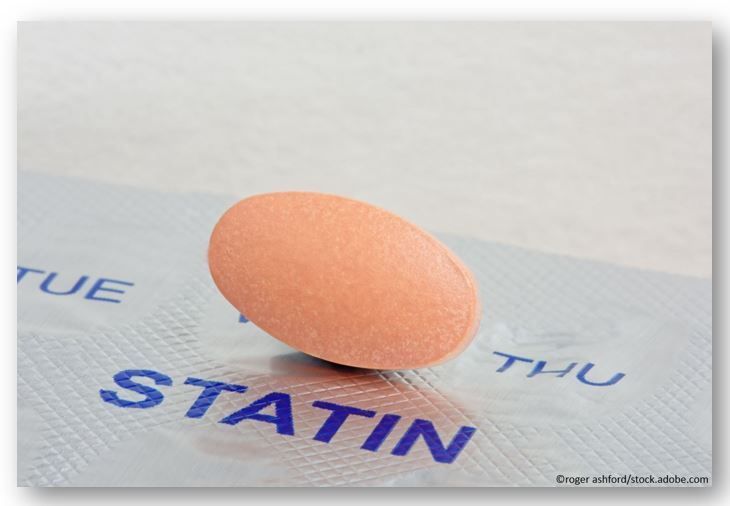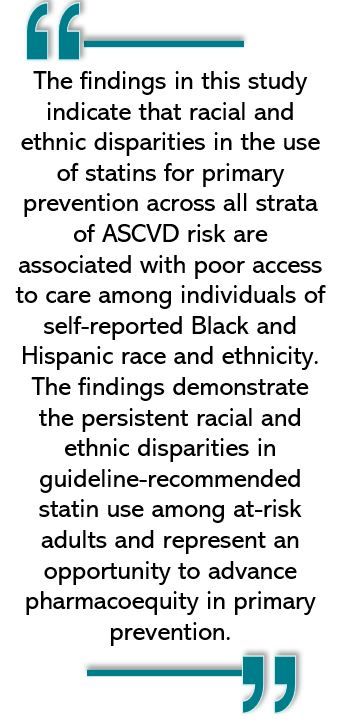- CDC
- Heart Failure
- Cardiovascular Clinical Consult
- Adult Immunization
- Hepatic Disease
- Rare Disorders
- Pediatric Immunization
- Implementing The Topcon Ocular Telehealth Platform
- Weight Management
- Monkeypox
- Guidelines
- Men's Health
- Psychiatry
- Allergy
- Nutrition
- Women's Health
- Cardiology
- Substance Use
- Pediatrics
- Kidney Disease
- Genetics
- Complimentary & Alternative Medicine
- Dermatology
- Endocrinology
- Oral Medicine
- Otorhinolaryngologic Diseases
- Pain
- Gastrointestinal Disorders
- Geriatrics
- Infection
- Musculoskeletal Disorders
- Obesity
- Rheumatology
- Technology
- Cancer
- Nephrology
- Anemia
- Neurology
- Pulmonology
Rate of Statin Use for Primary ASCVD Prevention Substantially Lower in Black, Hispanic Persons
Analysis of NHANES data between 2013-2020 found statin use low across racial/ethnic groups and significantly lower among Black and Hispanic participants.
A new cross-sectional analysis of National Health and Nutrition Examination Surveys (NHANES) data representing nearly 40 million US adults found that among participants with a guideline indication for statin therapy, treatment was substantially lower for Black and Hispanic participants compared with White participants.

Using data from NHANES cycles between 2013 and March 2020, investigators evaluated the prevalence of primary prevention statin use by race and ethnicity according to 10-year risk of atherosclerotic cardiovascular disease (ASCVD). They found prevalence of statin use low overall – across NHANES cycles, risk categories, and strata of race and ethnicity and particularly low for individuals with ASCVD risk of ≥20%.
The researchers, writing in JAMA Cardiology, also found that having health insurance or a regular location to receive health care were both significantly associated with higher statin use across racial and ethnic groups—suggesting that perhaps some barriers to pharmacoequity in primary ASCVD prevention may be modifiable.
It is well known that the burden of ASCVD in the US is much higher among Black and Hispanic persons than among White individuals, state study authors led by Joshua A. Jacobs, PharmD, Spencer Fox Eccles University of Utah School of Medicine. The significant impact of social determinants of health on these minority populations, they add, also translates into limited or complete lack of access to cardiology care.
Jacobs et al cite research on underuse of statins for secondary CVD prevention among Black and Hispanic patients but note similar investigations in primary prevention populations have been small and flawed in design, leaving gaps in knoweldge of national patterns and temporal trends in statin use in these groups.
To examine these gaps more closely, the researchers evaluated the prevalence of statin use for primary prevention of ASCVD by race and ethnicity according to pooled cohort equation (PCE)-predicted 10-year ASCVD risk strata among NHANES participants.
The investigators pooled participant data for 3 NHANES cycles between 2013 and 2020. The team calculated 10-year predicted ASCVD risk using the pooled cohort equation (PCE) and divided the risk into categories: 5% to <7.5%, 7.5% to <20%, and ≥20%. A total of 11 536 participants aged 40 to 75 years who self-identified as Asian, Black, Hispanic, or White were assessed for inclusion.
The primary outcome was the prevalence of statin use, defined as the identification after interviewer pill bottle review. For the primary analysis, Poisson regression with adjustment for NHANES cycle was used to determine the association of race and ethnicity and ASCVD risk stratum with statin use.
FINDINGS
The final cohort for analysis comprised 3417 participants, representing 39.4 million US adults after weight-based sampling. There were 1289 women and 2128 men with an average age of 61.8 years. Based on self-report, 329 participants were Asian (weighted percentage, 4.2%), 1032 were Black (12.7%), 786 were Hispanic (10.1%), and 1270 were White (73.0%). The proportion of participants with a 10-year predicted ASCVD risk of 5% to <7.5% was 31.0%, 7.5% to <20% was 58.3%, and ≥20% was 10.7%
When investigators compared statin use among racial and ethnic groups, overall prevalence was 25.5% (95% CI, 23.3 - 27.9). Use of the drugs was significantly lower among Black and Hispanic participants vs White participants

in the overall cohort (20.0% vs 27.9%, P<.001, and 15.4% vs 27.9%, P<.001, respectively) as well as across ASCVD risk strata. The analysis found no difference in overall statin use between Asian and White participants (25.5% vs 27.9%; PR, 0.98; 95% CI, 0.94-1.02; P=.38) or within each ASCVD risk strata.
While the investigators observed a graded increase in the prevalence of statin use across ASCVD risk strata within each race and ethnicity group, statin use in the highest risk strata (≥20%) was low overall and was significantly lower among Black participants (23.8; prevalence ratio [PR], 0.90; 95% [CI, 0.82 - 0.98) and Hispanic participants (23.9%; PR, 0.90; 95% CI, 0.81 - 0.99) compared with White participants (37.6%; reference group).
In adjusted analyses, higher ASCVD risk strata had significantly greater prevalence of statin use across each race and ethnicity group. Among measures of social determinants of health, access to routine health care and health insurance were found significantly associated with a greater prevalence statin use across all race and ethnicity groups.
“The findings in this study indicate that racial and ethnic disparities in the use of statins for primary prevention across all strata of ASCVD risk are associated with poor access to care among individuals of self-reported Black and Hispanic race and ethnicity,” investigators wrote. They add that the findings “demonstrate the persistent racial and ethnic disparities in guideline-recommended statin use among at-risk adults and represent an opportunity to advance pharmacoequity in primary prevention.”
Reference. Jacobs JA, Addo DK, Zheutlin AR, et al. Prevalence of statin use for primary prevention of atherosclerotic cardiovascular diseae by race, ethnicity, and 10-year disease risk in the US: National Health and Nutrition Examination Surveys, 2013 to March 2020. JAMA Cardiol. Published online March 22, 2023. doi:10.1001/jamacardio.2023.0228
